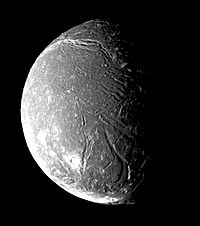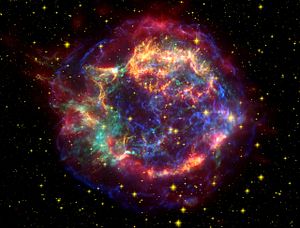
Portal:Astronomy
- Wikipedia portals: Culture
- Geography
- Health
- History
- Mathematics
- Natural sciences
- People
- Philosophy
- Religion
- Society
- Technology
Astronomy portal
Astronomy (from Ancient Greek ἄστρον (astron), meaning "star", and νόμος (nomos), meaning "law, culture") is the study of the evolution and physical and chemical properties of celestial objects. Astronomical observations are not only relevant for astronomy as such, but provide essential information for the verification of fundamental theories in physics, such as the general relativity theory. Complementary to observational astronomy, theoretical astrophysics seeks to explain astronomical phenomena.
Selected article
After Miranda, Ariel is the second-smallest of Uranus's five round satellites, and the second-closest to its planet. Among the smallest of the Solar System's 19 known spherical moons (it ranks 14th among them in diameter), Ariel is composed of roughly equal parts ice and rocky material. Like all of Uranus's moons, Ariel probably formed from an accretion disc that surrounded the planet shortly after its formation, and, like other large moons, it may be differentiated, with an inner core of rock surrounded by a mantle of ice. Ariel has a complex surface comprising extensive cratered terrain cross-cut by a system of scarps, canyons and ridges. The surface shows signs of more recent geological activity than other Uranian moons, most likely due to tidal heating.
Did you know
... that William Herschel's 40-foot telescope (pictured) was the largest telescope in the world for 50 years?
...that Zeeman-Doppler imaging is a technique used to map the surface magnetic field of stars?
...that Astronomische Nachrichten, founded by H. C. Schumacher in 1821, is the world's oldest existent astronomical journal?
...that the Stingray Nebula, thought to have formed around 1987, is the youngest known planetary nebula?
...that the Mark II radio telescope built in 1964 at Jodrell Bank Observatory, UK was the first ever telescope to be controlled by a digital computer?
...that Comet Shoemaker-Levy 9 passed within Jupiter's Roche limit in 1992, causing it to break up into smaller pieces two years before it collided with the planet?
...that the Kaidun meteorite fell on March 12, 1980 on a Soviet military base in Yemen and may be from Phobos?
Categories
Astronomy : Archaeoastronomy - Astrophysics - Calendars - Catalogues - Celestial coordinate system - Celestial mechanics - Cosmology - Images - Large-scale structure of the cosmos - Observatories - Planetary science - Telescopes
Biographies : Astronomers - Other people
Astronomical objects : Lists - Galaxies - Nebulae - Planets - Stars
Spaceflight : Human spaceflight - Satellites - SETI - Spacecraft
Projects
 |
|
| WikiProject Astronomy | WikiProject Solar System |
|---|---|
|
|
|
 |
 |
| WikiProject Astronomical objects | WikiProject Spaceflight |
 |
 |
 |
| Star | Spaceflight | Moon |
|---|---|---|
 |
|
 |
| Space | Solar System | Mars |
 |
 |
|
| X-ray astronomy | Science | Jupiter |
Selected picture
Cassiopeia A (Cas A) is a supernova remnant in the constellation Cassiopeia and the brightest astronomical radio source in the sky, with a flux of 2720 Jy at 1 GHz. The supernova occurred approximately 11,000 light-years (3.4 kpc) away in the Milky Way.
Astronomy News
Wikinews Space portal
- January 31: Main belt asteroid No. 274301 named 'Wikipedia'
- June 17: Study says young stars 'shoot water bullets'
- January 11: Moon water possibly originated from comets, data shows
- October 15: Brazilian astronomers propose new model of our galaxy
- October 1: New planet found in 'Habitable Zone'
- September 19: Jupiter at its brightest in 47 years
- August 25: Astronomers discover large exo-solar system
- August 22: Scientists say the moon is slowly shrinking
March anniversaries
- 13 March 1781 – William Herschel discovers the planet Uranus.
Things you can do
|
Here are some Open Tasks :
Astronomy featured article candidates:
Astronomy articles for which peer review has been requested:
|
Wikibooks
These books may be in various stages of development. See also the related Science and Mathematics bookshelves.
- Astronomy
- GAT: A Glossary of Astronomical Terms
- Introduction to Astrophysics
- General relativity
- Observing the Sky from 30°S
- Observing the Sky from 40°N
Wikijunior
- Solar System
Astronomical events
All times UT unless otherwise specified.
| 4 March, 13:00 | Mercury at inferior conjunction |
| 5 March, 23:14 | Moon at perigee |
| 9 March, 20:42 | Comet PANSTARRS at max brightness |
| 11 March, 19:51 | New moon |
| 13 March, 15:00 | Gamma Normids peak |
| 19 March, 03:14 | Moon at apogee |
| 20 March, 11:02 | Earth at northward equinox |
| 20 March, 23:42 | Comet Lemmon at max brightness |
| 27 March, 09:27 | Full moon |
| 28 March | Uranus at conjunction |
| 28 March, 17:06 | Venus at superior conjunction |
| 31 March, 04:00 | Moon at perigee |
| 31 March, 21:48 | Mercury at greatest western elongation |
2013: January | February | March
2012: January | February | March | April | May | June | July | August | September | October | November | December
2011: January | February | March | April | May | June | July | August | September | October | November | December
2010: January | February | March | April | May | June | July | August | September | October | November | December
2009: January | February | March | April | May | June | July | August | September | October | November | December
2008: January | February | March | April | May | June | July | August | September | October | November | December
2007: January | February | March | April | May | June | July | August | September | October | November | December
2006: January | February | March | April | May | June | July | August | September | October | November | December
2005: May | June | July | August | September | October | November | December
- What are portals?
- List of portals
- Featured portals






